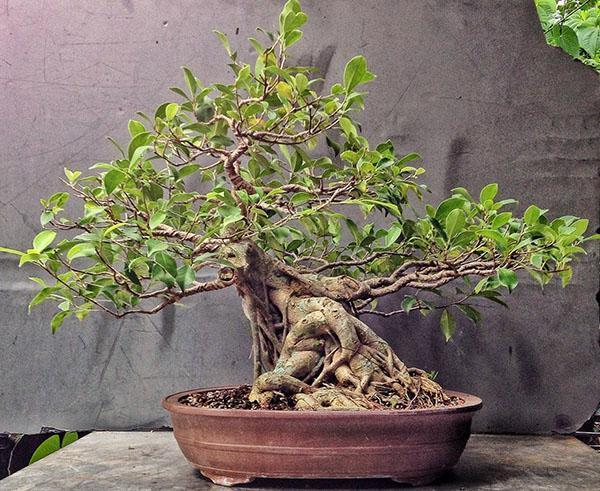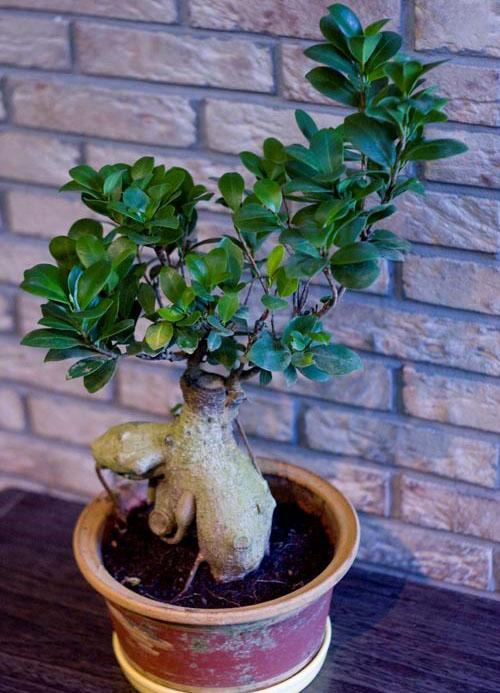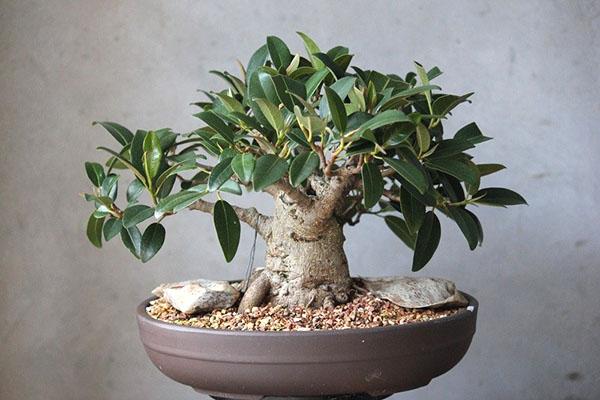Growing ficus bonsai at home
 For the cultivation of bonsai, ficus has been used not so long ago, but this did not prevent the plastic and responsive plant from becoming one of the favorite among bonsaiists. It is hard to imagine that even a beginner, with a certain amount of patience and diligence, manages to give the Benjamin's ficus or microcarp the appearance of an adult, but a miniature tree, only 30-60 cm high.
For the cultivation of bonsai, ficus has been used not so long ago, but this did not prevent the plastic and responsive plant from becoming one of the favorite among bonsaiists. It is hard to imagine that even a beginner, with a certain amount of patience and diligence, manages to give the Benjamin's ficus or microcarp the appearance of an adult, but a miniature tree, only 30-60 cm high.
However, exactly so! Moreover, work on such a bonsai will last not 15–20 years, but much less. The reason is the enviable pliability of the tree, in favorable conditions:
- excellent aerial roots;
- overgrowing wounds on the trunk;
- forming new branches instead of cut ones;
- shapeable with wire and cord.
Even a tree that has grown to a standard size in the hands of an enthusiast can become an original bonsai in a few years. What does it take to turn the most common Benjamin ficus on our windows into bonsai?

Ficus bonsai care at home
 Although the bonsai appears to be frozen in development, the plant is alive and requires proper care, including:
Although the bonsai appears to be frozen in development, the plant is alive and requires proper care, including:
- watering;
- top dressing;
- transplants.
In the warm season, the ficus should be under a bright, but not exhausting sun for at least 12 hours. When choosing a place for a pot, you need to give preference to a corner protected from drafts and hot air, which comes from batteries in winter.
The optimum temperature for ficus bonsai is 18-25 ˚C. If you provide a tree with sprinkling, it will survive the heat without shocks, but a cold snap below 15 ˚C will be a serious test for a tropical culture. In cold, damp soil, the roots of bonsai-grown ficus microcarp or Benjamin can rot, which is fraught with the loss of the plant.
 The frequency of watering depends on the season, air temperature and soil conditions. In warm weather, they are usually guided by the drying of the topsoil. In summer, the plant needs moisture more than in winter.
The frequency of watering depends on the season, air temperature and soil conditions. In warm weather, they are usually guided by the drying of the topsoil. In summer, the plant needs moisture more than in winter.
Dry air helps to compensate for crown irrigation. The same measure promotes the formation of aerial roots, which are necessary if bonsai in the form of a banyan are to be grown from small-leaved ficus.
Specialized feeding for bonsai growing in very limited amounts of soil is needed. They are carried out at intervals of 2-3 weeks, a month after the transplant. Foliar fertilization works great.
Choosing a pot and soil for ficus bonsai
 In addition to traditional formative pruning, ficus for bonsai needs to remove dead or damaged shoots and roots. Pests can settle on it. Compared to conventional indoor ficuses, caring for bonsai at home is more laborious and painstaking.
In addition to traditional formative pruning, ficus for bonsai needs to remove dead or damaged shoots and roots. Pests can settle on it. Compared to conventional indoor ficuses, caring for bonsai at home is more laborious and painstaking.
Bonsai are always grown in flat, heavy pots. This is not a tribute to tradition, but a necessity in order to limit the volume of roots and inhibit the growth of the aboveground part, as well as for greater stability of the tree.
In this case, at the bottom of the selected pot there must be at least one drainage hole. For air access and drainage of water, ceramic containers may have legs. Convenient when there is a pallet in the kit.For bonsai grown ficus benjamin photo with a height of 30 to 50 cm, a pot with a depth of about five centimeters is sufficient. The shape and diameter are chosen according to the style of the plant and the idea of the composition.
 In order for the plant to feel comfortable, receive enough moisture and nutrition, the pot must be filled with the correct soil. In Japan, bonsai is grown on a clay substrate in the form of granules of various sizes. If you don't have such a composition at hand, you can buy soil for palm trees or mix the soil yourself on the basis of equal shares:
In order for the plant to feel comfortable, receive enough moisture and nutrition, the pot must be filled with the correct soil. In Japan, bonsai is grown on a clay substrate in the form of granules of various sizes. If you don't have such a composition at hand, you can buy soil for palm trees or mix the soil yourself on the basis of equal shares:
- humus;
- sorted out peat;
- clay powder;
- washed sand.
 As ingredients for the substrate, you can take fine expanded clay and perlite, sheet earth and vermiculite. The composition can be different, the main thing is that the soil for transplanting ficus bonsai is loose, aerated and contains enough nutrition for the growth of the tree.
As ingredients for the substrate, you can take fine expanded clay and perlite, sheet earth and vermiculite. The composition can be different, the main thing is that the soil for transplanting ficus bonsai is loose, aerated and contains enough nutrition for the growth of the tree.
Ficuses look great on stones, over time entwining them with roots and creating a complete illusion of a natural picture. Before making a bonsai from a ficus with such a neighborhood, the roots of the plant are treated with thick clay gruel, fixed with wire and provided contact with the soil.
How to grow bonsai from Benjamin ficus with your own hands?
 Young plants for growing bonsai are obtained by rooting green apical cuttings from 8 to 12 cm long. On such segments of shoots there are several dormant growth points, which will later become the branches and roots of the tree. Cuttings:
Young plants for growing bonsai are obtained by rooting green apical cuttings from 8 to 12 cm long. On such segments of shoots there are several dormant growth points, which will later become the branches and roots of the tree. Cuttings:
- dry in places of cuts;
- treated with crushed activated carbon;
- put in a growth stimulant solution.
In a greenhouse at an air temperature of 25–27 ˚C, high humidity and bright light, bright light on the planting material will soon appear the rudiments of roots. When the plants are able to start an independent life, they are transplanted one by one or several seedlings in pre-prepared pots with sandy drainage and soil for bonsai. stones can be used immediately for decoration.
Formation on Benjamin ficus bonsai begins with pinching the top point of growth when the plant reaches the intended height.
Ficus Benjamin Bonsai Formation
 Benjamin's ficus is rightfully considered the most famous among flower growers. However, other species are also suitable for growing miniature trees of incredible shapes, for example, Bengal ficus, rust-leaved, fig, familiar from tasty and healthy fruits.
Benjamin's ficus is rightfully considered the most famous among flower growers. However, other species are also suitable for growing miniature trees of incredible shapes, for example, Bengal ficus, rust-leaved, fig, familiar from tasty and healthy fruits.
And based on ficus Microcarpa bonsai is even easier to grow than a small-leaved Benjamin seedling. In this case, you can use radical cropping to remove all the green part. The remaining stem with roots will serve as the basis for the future bonsai.
On several seedlings planted in one pot, a technique such as weaving is often used. To do this, the trunks of the plants, while they are not coarse and lignified, are carefully intertwined, fixing the selected position with a rope. In order for the stems to grow together, in the places of their contact, the bark is removed and the wood is treated with a special compound.
 In bonsai, it is especially appreciated when the tree fully reproduces the picture from life, so not only the trunk, but also the roots will have to be formed. Work on them begins 3-4 months after the rooting of a young ficus. With the help of a special spatula and stick, the root system of the plant, starting from the root collar, is carefully freed from the soil. During transplantation, the excess roots are removed or the entire bunch is shortened. Appearing, for example, on bonsai from ficus microcarp, aerial rhizomes are directed to the soil, straightened and added dropwise to obtain a spectacular banyan tree.
In bonsai, it is especially appreciated when the tree fully reproduces the picture from life, so not only the trunk, but also the roots will have to be formed. Work on them begins 3-4 months after the rooting of a young ficus. With the help of a special spatula and stick, the root system of the plant, starting from the root collar, is carefully freed from the soil. During transplantation, the excess roots are removed or the entire bunch is shortened. Appearing, for example, on bonsai from ficus microcarp, aerial rhizomes are directed to the soil, straightened and added dropwise to obtain a spectacular banyan tree.
 The work with changing the shape of the barrel is very careful. There is no rush here.
The work with changing the shape of the barrel is very careful. There is no rush here.
When choosing materials, it is better for beginners to give preference to rope or cloth tape than wire that can spoil the wood.If you cannot do without wire, it is better to take the braided material, laying felt or other fabric under it.
Winding with a rope or wire is done from the bottom up, from the base of the shoot or trunk to its top. Change the direction carefully so as not to break the branch. The fixation remains on the tree for 45-60 days, after which it is cut.
 One of the most important techniques when growing bonsai from Benjamin's ficus with your own hands is pruning. It is carried out with the help of sharp scissors and a knife at least once every 6 months. The best time is early spring, then until autumn you can adjust the shape without fear of seriously harming the plant:
One of the most important techniques when growing bonsai from Benjamin's ficus with your own hands is pruning. It is carried out with the help of sharp scissors and a knife at least once every 6 months. The best time is early spring, then until autumn you can adjust the shape without fear of seriously harming the plant:
- Roots and whole branches are cut smoothly without stumps.
- Places of large cuts are processed with garden pitch.
- Pruning of branches begins when they have 8-10 leaves.
- Removal of leaves is carried out carefully, avoiding exposure of the crown.
Ficus bonsai transplant
 Adult bonsai from ficuses are transplanted infrequently, and the older the tree and the lower the growth rate, the less often it is necessary to do this.
Adult bonsai from ficuses are transplanted infrequently, and the older the tree and the lower the growth rate, the less often it is necessary to do this.
Until the age of five, plants are transferred to a new soil and pot every two years. Then you can not touch the ficus for almost 5 years.
During bonsai transplantation, ficus undergoes root system correction. It is cleaned of dead parts and cut from the bottom by a third. The field of this plant is transferred to fresh soil, after taking care of drainage. The ficus, compacted and fixed in a pot, is watered, and after half an hour, excess moisture is drained.